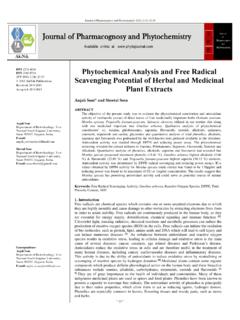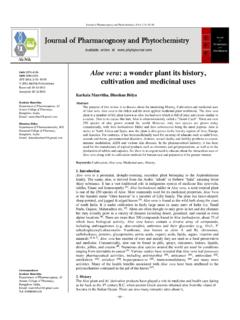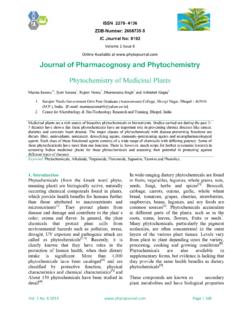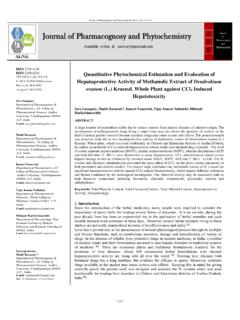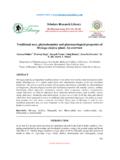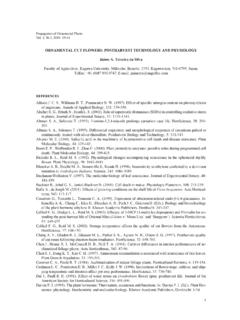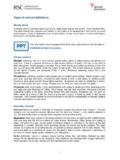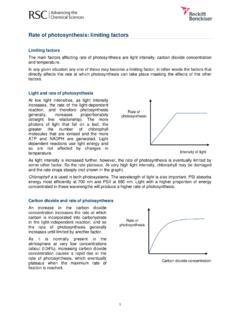Transcription of Tannins are Astringent - Pharmacognosy Journal
1 ISSN 2278- 4136 ZDB-Number: 2668735-5 IC Journal No: 8192 Volume 1 Issue 3 Online Available at Journal of Pharmacognosy and Phytochemistry Vol. 1 No. 3 2012 Page | 45 Tannins are Astringent Praveen Kumar Ashok1*, Kumud Upadhyaya2 1. Faculty of Pharmacy, GRD(PG)IMT , Rajpur Road , Dehradun, Uttarakhand (India). [E-mail: ] 2. Faculty of Pharmacy, Kumaun University, Bhimtal, Nainital, Uttarakhand (India) Tannins are obtained upon the decomposition of vegetation. They will generally be found in surface water supplies or shallow wells.
2 Although these compounds are not a health risk, they are aesthetically displeasing. Tannins are difficult to remove from water. Tannins can cause a yellow to brown cast in water and may also affect a taste and odour. Keyword: Tannins , Astringent , Phenol, Tea, Wine 1. Introduction "Any phenolic compound of sufficiently high molecular weight containing sufficient hydroxyls and other suitable groups ( carboxyls) to form effectively strong complexes with protein and other macromolecules under the particular environmental conditions being studied". Tannins are Astringent , bitter plant polyphenols that either bind and precipitate or shrink proteins.
3 The astringency from the Tannins is that which causes the dry and puckery feeling in the mouth following the consumption of red wine, strong tea, or an unripened fruit[1]. The term tannin refers to the use of Tannins in tanning animal hides into leather; however, the term is widely applied to any large polyphenolic compound containing sufficient hydroxyls and other suitable groups (such as carboxyls) to form strong complexes with proteins and other macromolecules. Tannins have molecular weights ranging from 500 to over 3000[2].
4 Tannins are found as shapeless yellowish or light brown masses like powder, flakes or sponge. Interestingly, Tannins are found almost in all plants and in all climates all over the world. The name tannin is derived from the French word tanin (tanning substance) and is used for a range of natural polyphenols. Lower plants such as algae, fungi and mosses do not contain much tannin. The percentage of Tannins present in the plants, however, varies. While they are present in significant proportions in some plants, many others have too little of them.
5 Tannins are usually found in large quantities in the bark of trees where they act as a barrier for micro-organisms and protect the tree. Apart from tanning, Tannins are also used in dyeing, photography, refining beer and wine as well as an Astringent in medicines. Significantly, Tannins form a vital element of tea [3]. While soluble, Astringent materials are found in some plants like tea and coffee, Tannins are supplemented to various processed foods, including ice-cream and caramel. They are also Praveen Kumar Ashok Vol.
6 1 No. 3 2012 Page | 46 used as refining materials to precipitate proteins in wines and beer. As Tannins often lower the absorption of some materials into the body, Tannins are also often known as anti-nutrients. For example, Tannins are found in tea and coffee and consuming too much of these beverages without milk may lead to calcium and iron deficiency in the body and often lead to osteoporosis and anemia[4]. In order to counter these problems, it is advised that one should take tea or coffee between meals and not consecutively.
7 In addition, adding milk or lemon juice to the tea helps in reducing or neutralizing Tannins adverse actions on iron intake. Similarly, consuming food that is rich in vitamin C also helps in neutralizing tannin s effects on iron absorption[5]. Table1: Tannins can be classified into three broad groups hydrolysable Tannins , condensed Tannins and Pseudotannins. Base Unit: Gallic Acid Flavone Phloroglucinol Class/Polymer: Hydrolyzable Tannins Condensed Tannins Phlorotannins Sources Plants Plants Brown algae The apple contains several phenolic substances, , chlorogenic acid, catechin, epicatechin, phlorizin, rutin, flavonoids, and condensed Tannins .
8 The apple condensed Tannins (ACT) are contained in unripe apples at a ten times higher level than in the ripe ones[6]. Condensed Tannins are called proanthocyanidins, and have a wide distribution in plants as secondary metabolites. We consume small amounts of these compounds in daily life from fresh fruits such as apple and the processed foods made from these fruits. Rather than nutrients, plant proanthocyanidins are known as the functional food factors that possess a variety of physiological activities including antioxidant[7-9].
9 Occurrence Tannins are distributed all over the plant kingdom. Tannins are formed upon the decomposition of vegetation. These compounds are large molecular weight organics that fall under two large primary categories: Humic acids and Fulvic acids. These are simplified structures, but they show the complexity of Tannins . Gallic Acid, Guaiacyl, Syringyl and Cresylic Moieties are the building blocks of these large organic molecules[10]. The structure of the tannin varies, depending on the plant life in a given area.
10 Tannins are found in leaf tissues, bud tissues, seed tissues, root tissues and stem tissues. An example of the location of the Tannins in the stem tissue is that they are often found in the growth areas of trees, such as the secondary phloem and xylem and the layer between the cortex and epidermis. Tannins may help regulate the growth Praveen Kumar Ashok Vol. 1 No. 3 2012 Page | 47 of these tissues. They are also found in the heartwood of conifers and may play a role in inhibiting microbial activity, thus resulting in the natural durability of the wood[11].


